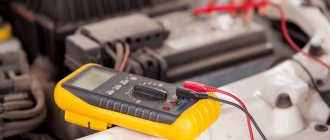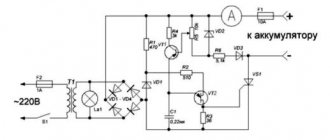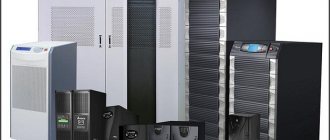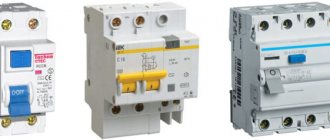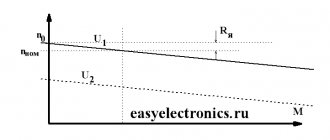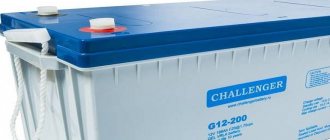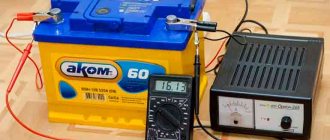The absence of a battery or its complete discharge is what excludes the possibility of using the vehicle, since it simply cannot be started. This explains the need for some awareness regarding the correct choice of a new battery.
The modern market is distinguished by a variety of battery brands, technologies and design options. The cost of domestic models on average ranges from 3,000 to 4,000 rubles, and imported samples of these products “please” with price tags with four zeros.
Which ones are better? Should we give preference to foreign batteries or are ours also quite functional? Which battery is more efficient? To understand the answers to these questions, you will need some knowledge, as suggested below.
Old used batteries are subject to mandatory recycling. Find out how to return your battery and how much you can get for it at the collection point.
Brand
The choice of domestic or imported battery is not clear-cut. On the one hand, European products are of higher quality than ours, and on the other, there are many factors that smooth out this discrepancy.
Let's touch on the battery testing standard. In Europe, the battery test involves applying a load for 30 seconds, which does not cause the voltage to drop below 9 volts. Things are different here. In accordance with GOST, the load is supplied within 10 seconds.
As a result, we can admit that European batteries are of higher quality. Although positive trends are also observed in our market. Some manufacturers offer products that have passed European certification.
If you choose from foreign brands, you can choose BOSH (famous and time-tested). In the case of a domestic manufacturer, this could be, for example, AkTex Standard. Unscrupulous manufacturers are mostly associated with China and Turkey.
In any case, you should not chase a well-known brand, but purchase the unit that, according to its characteristics, is suitable for your car. This requires compliance with very specific parameters: capacity, dimensions, starting current, etc.
About industrial standards DIN and SAE (Taken from https://www.nt.org/tp/ie/saae.htm)
All enterprises in Europe and a significant part of them in Asia are guided by the German industrial standard DIN 43 539, which regulates the main technical parameters and test methods for starter batteries. For starter batteries, the DIN standard defines two main parameters:
nominal capacity C20;
cold discharge test current IP at electrolyte temperature –18°C.
The cold discharge test current is selected from the condition of discharging the battery to a voltage of 9 V in 30 seconds. Index 20 in the designation of nominal capacity means the battery capacity for a 20-hour discharge mode.
The nominal capacity of C20 is determined at a 20-hour discharge mode and is measured in ampere-hours (see Chapter 2 of the book “Batteries and Accumulators”). For batteries from a European manufacturer, for example, with a rated voltage of 12 V and C20 = 55 Ah, the discharge time with a current I = C20/20 = 2.75 A to a voltage of 10.75 V will be more than 20 hours. The cold discharge test current of such a battery, IP = 255 A, will discharge a charged battery to a voltage of 9 V in 30 seconds.
Batteries from American manufacturers are produced and tested according to the requirements of the American standard SAE J 537. It also normalizes two main parameters:
reserve (nominal) capacity CP;
cold discharge test current ICC at electrolyte temperature –18°C.
The reserve capacity CP, regardless of the capacity and purpose of the batteries, from an American manufacturer is determined by the discharge time in minutes at a current of 25 A. The test cold discharge current ICC at an electrolyte temperature of –18°C is the value of the discharge current at which, after 30 seconds of discharge, the battery voltage will be not lower than 7.2 V.
Manufacturers mark the voltage value, reserve capacity and cold discharge test current on the battery case. The battery housing contains generally accepted mnemonic symbols (see Chapter 2).
The following formulas allow you to recalculate the main parameters of the DIN 43 539 and SAE J 537 standards to select an equivalent battery replacement.
To convert the basic parameters of the European standard to the American standard:
to convert the main parameters of the American standard to the European standard:
For example, a battery with a cold discharge test current IP = 255 A (according to DIN 43 539) will correspond to a cold discharge test current ICC = 255 x 1.87 = 477 A (according to SAE J 537). And a battery with a capacity of C20 = 55 Ah will correspond to a reserve capacity of CP = 87 min.
The type designation for domestic and a number of foreign batteries indicates the nominal capacity, i.e. capacity under normal discharge conditions (discharge with rated current and, usually, at a temperature of 20°C).
Maintainability
It is customary to distinguish 3 categories of batteries depending on their maintainability:
- Serviceable ones have access to the inside, which is provided by a special cover. They are inexpensive in terms of price, but have an insufficient service life (about 2 years) and require constant attention, which is associated with monitoring the electrolyte level.
- Low-maintenance – less demanding maintenance compared to the first category. Although the need for regular filling of electrolyte is not excluded. The warranty period has been increased to 3 years.
- Unattended - no access inside. Long service life (on average about 5 years).
Date of manufacture
New batteries require proper storage. A battery age exceeding 1 year is critical, as during this period it becomes unusable without recharging. One can hardly hope that sellers regularly recharge the battery in the window.
In this regard, the maximum permissible age of the battery should be 4 months. Anything older requires mandatory verification. This especially applies to products of the type in question with a manufacturing date of more than 1 year ago.
Beware: fakes
Due to the growing demand for car batteries, low-grade counterfeits have appeared. Before purchasing, it is necessary to carefully inspect the body and plugs of the device for chips; terminals and contacts for surface smoothness and presence of protective caps. Manufacturers of counterfeit products rarely pay attention to such trifles.
We need to check the existence of the manufacturing date, see if the numbers are mixed up. Be sure to check the technical data sheet for the battery. Buy batteries only from well-known brands. After purchase, keep the receipt and warranty card.
Which battery is best to buy depends on several decisions based on the requirements of the vehicle's operating conditions. A correctly selected battery will last 5–7 years.
Capacity
You should not skimp on battery capacity. Installing a battery with a smaller capacity can lead to the following:
- constant recharge, since the generator power will remain the same;
- increasing the rate of battery aging;
- insufficient power supply to the vehicle's on-board network;
- reducing the chances of starting the car when cold weather sets in.
It is advisable to use a battery whose capacity exceeds the standard established by the manufacturer by 5–10 percent. For example, if you had a 55 Ah battery, you can replace it with a 60 Ah battery.
Choosing a car battery based on generator power
To choose the right battery, do not forget about the power of the generator . It is advisable to immediately check with the car’s passport. If the car enthusiast is not the first owner of the car, then it is better to look under the hood yourself and check the power. In this case, the battery capacity is selected in such a way that the maximum charging current (about 15A) and the power of all electrical appliances are completely covered by the generator.
For example, a VAZ car has an 80A generator. Accordingly, for its normal operation, the load should not exceed 76A - we discard 5% to prevent overloading the device. Another 20% of the power will be consumed by on-board electrical appliances, and accordingly, the maximum comfortable battery for operating the generator will be 60A*h.
Terminal type
Depending on the type of battery terminals, they are divided into:
- American;
- Asian;
- European.
More complete information on this issue can be obtained by reading the instruction manual supplied by the manufacturer. This kind of information is also available on the relevant Internet resources.
In short, the terminals differ in size and installation methods. For example, European terminals are more recessed into the housing, which makes them safer in terms of the risk of short circuits compared to Asian ones. Moreover, the latter are thinner than European ones.
Some argue that European batteries are quite suitable for Asian cars and vice versa. This statement is not entirely true. Any discrepancy in the design of the vehicle has a negative impact on the safety of its operation. There is a sufficient selection of batteries in retail chains, so it is better to install the battery provided by the car manufacturer.
dimensions
How to avoid problems with choosing the wrong battery size?
There are several ways to solve the problem of how to choose a battery based on dimensions: either study your old model in detail (with measurements in width, length and height), or make inquiries at the service center, receiving advice specifically for your car (whether it’s an American Chevrolet, Japanese "Toyota" or domestic "VAZ").
It is worth noting that the dimensions of almost all batteries, as well as the configuration of the housings, are made with a large degree of identity. Most often, the main difference between them is the weight parameter, which, in fact, does not play a big role when installed in a car. The only exception here is the Japanese auto industry with its original corporate “atmosphere”. Their batteries are narrower and higher than European ones, so installing a battery from a conventional VAZ, alas, will not work.
Polarity
The choice of battery must be correlated with its polarity. This refers to the different arrangement of the terminals, which determines the polarity, characterized as reverse or direct.
In the case when the minus sign is on the left side of the case, we can talk about reverse polarity. If this is not the case, that is, there is a “plus” on the right, the polarity is considered straight.
Starting current
The marking of any car battery allows you to determine a parameter indicating the amount of starting current. You should know this parameter in relation to your car.
You should not take a battery with a lower starting current than required. The use of a weak battery option will manifest itself as a negative in the winter, when the temperature exceeds minus 18 degrees. Such a battery may lose about 40% of its capacity, which will prevent the car from starting.
At the same time, more powerful batteries are not always the way out of this situation, since they have a high price tag. This suggests a recommendation: choose the optimal combination of price and power.
Battery type (antimony, calcium, hybrid)
With a certain degree of convention, all lead-acid batteries are divided into three main types:
- antimony;
- calcium;
- hybrid.
In relation to a specific type of battery, one or another composition is used, with the help of which the lead plates acquire specific characteristics.
Antimony
The oldest technology, based on improving the quality of lead from which battery plates are made, involves the addition of antimony (5–7%). When the charge reaches a value of 12.2 to 12.5 volts, the electrolysis process enters the most active phase. The electrolyte begins to literally boil when the voltage reaches 12.7 volts. Such active processes lead to rapid evaporation of water.
The positive aspect of such batteries is the strength of their plates. Even deep discharges do not provoke their early shedding. As a result, their strength is maintained for quite a long time. The negative aspects of antimony batteries include the need for constant monitoring of the electrolyte level. This also adds too much electrochemical fluid compared to other types of batteries, which exceeds the mass of the plates. This serves as an obstacle to increasing the capacity of antimony batteries and the inrush current parameter.
The rapid electrolysis process does not allow the housing to be completely sealed, as it can rupture. Moreover, such batteries are characterized by high self-discharge, reaching 2% of capacity within a day.
Low antimony
Batteries of this type are a subtype of the previous ones, since they are identical from a technological point of view. Their main difference is that the plates contain less antimony (2–4%). This fact ensures less intense boiling of the electrolyte. A lower antimony content leads to a decrease in the strength of the plates. The batteries themselves move into the “low-maintenance” category.
Calcium
A relatively new technology that involves adding calcium to the plates. Quite often there is a Ca/Ca marking, indicating that both plates (plus and minus) contain the mentioned element. With the help of calcium, it is possible to achieve an almost complete cessation of water evaporation, which brings calcium batteries closer to the “maintenance-free” category. In some cases, the plates are saturated with a small percentage of silver: the internal resistance decreases, which means a larger battery capacity and an increase in the starting current parameters.
The positive characteristics of calcium batteries should be understood as an acceptable level of self-discharge (lower compared to antimony batteries), high capacity and the start of the electrolysis process only at 16 volts.
Negative characteristics include the requirement for deep discharges, when an 80% loss of capacity is achieved after 3-4 such discharges. When choosing, you need to take into account the high cost of such products.
Hybrid
An attempt to combine the two technologies led to the emergence of hybrid batteries. The essence of this process comes down to the fact that there is antimony on one plate, and calcium on the other. As a result, there is evaporation of water, but not so critical, the capacity and inrush currents are increased, and the resistance to deep discharges is improved. The cost is average between antimony and calcium batteries.
As for other technologies, for example, GEL and AGM, their consideration can be considered premature, which is associated with the high cost of the final product. The price tag, for example, for helium batteries can reach 20,000 rubles. While calcium is sold for an amount 3 times less. To this we can also add the dislike of gel batteries to be recharged.
If you lack funds, it is better to choose a hybrid battery, and if you are not constrained by expenses, it is better to choose a calcium battery.
Check in store
The process of purchasing a specific battery, when you find yourself in a store, should begin with a visual inspection of the selected sample.
You should make sure that the battery case is intact: chips and cracks are unacceptable. A case that has been subjected to deformation cannot guarantee the safety of the electrolyte, and this significantly reduces the battery life.
Careless loading that causes dents also increases the likelihood of fluid leakage. Borns require verification to the same extent. There should not be any scratches on them. The detection of such defects can serve as confirmation that the battery has been previously used.
The next step is to contact the seller about measuring the battery charge and measuring the electrolyte density. If you are refused to carry out these actions, then it is better to refrain from purchasing.
Charging the battery must be done using a special tool in the form of a charging fork. According to Russian standards, voltage is applied within 10 seconds. The possible result is as follows:
- voltage without load is from 12 to 12.9 volts, which is normal;
- voltage drop under load, when the lower value can drop to 9 volts. Ideally, the voltmeter in this situation shows 11 volts. In the case when the created load leads to very low voltage values (less than 9 volts), you should refuse to purchase a battery.
As for the density of the electrolyte, it may be lower than that declared by the manufacturer, but within 0.02 m3.
Guarantee
Products manufactured under well-known brands have a long service life. Typically, such manufacturers provide a warranty of 4–5 years. The market also offers batteries with a shorter warranty period of 2–3 years. Compared to the first ones, they have lower prices, but otherwise these products are of quite acceptable quality. In any case, you can trust both of them.
Problematic batteries are those for which the manufacturer provides a minimum warranty period: up to 1 year or less. Such batteries are suspicious, so it is better to exclude them from your shopping list.
Once you decide on a specific battery model, do not forget to issue a warranty card from the seller and receive a receipt. This will avoid trouble. The battery may not suit your car and may simply be faulty. The presence of the mentioned documents makes it possible to exchange the goods.
Battery marking
List of necessary and mandatory information written on the battery case:
- Name, address of the plant. Manufacturer code.
- Minimum voltage, expressed in volts.
- Battery capacity.
- Symbols indicating the type of battery according to international standards.
- Number of cans.
- Date of manufacture.
- Terminal polarity.
If any item from the list is missing, you should look for another battery.
